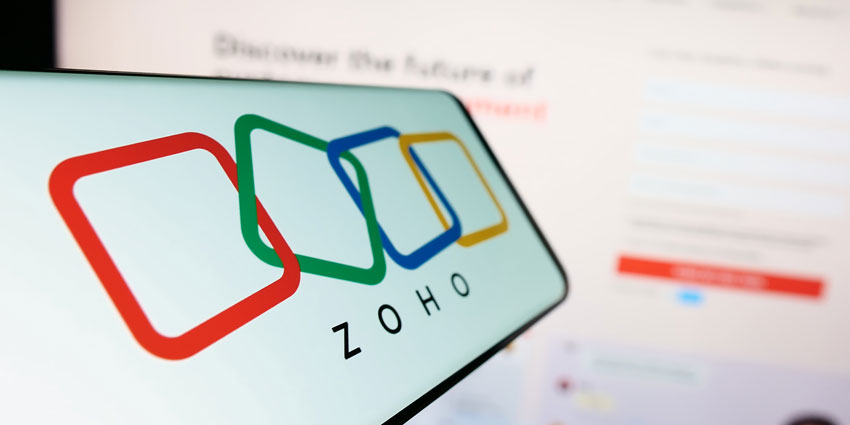Zoho has announced several new AI solutions for its ecosystem.
That ecosystem comprises AI tools integrated into the user experience, so they work in the background without the user even knowing it’s AI.
Yet, there are also default Zia Agents that cross Zoho’s products. Businesses can deploy these agents – often at no extra cost – to automate simple tasks or as “digital employees” within a system.
Zoho has built and hosted much of this AI on its own infrastructure, enabling the business to better manage costs and its roadmap.
Now, it has made several significant steps along this roadmap. Here are five of the highlights.
1. Zoho Launches Zia LLM
Zia LLM is a set of three large language models that Zoho has built in-house.
These models come with different parameter sizes:
- 1.3 billion parameters
- 2.6 billion parameters
- 7 billion parameters
Each model was trained separately, meaning that the two smaller models are not distilled versions of the larger seven billion model.
Zoho has promised that more models will be released in the future, too.
Why? To provide right-sized models that appropriately balance accuracy and cost.
Celebrating the launch, Raju Vegesna, Chief Evangelist at Zoho, noted:
Our AI assistant (Zia) is already performing well with the new LLM. We like the progress we’re seeing.
Indeed, according to Vegesna, Zia LLM already performs better than LLama 2. However, the Zoho man admitted that it’s “not quite at the level” of LLama 3, yet!
Critically, Zoho customers won’t be limited to using only Zia LLM. The CRM giant also supports various third-party LLMs, including those from OpenAI, Google, and others.
If customers prefer to use those models, they can do so through the vendor’s AI Bridge.
Zia LLM will be one option within the AI Bridge, and businesses can choose what works best for them. In some cases, it may be a combination of these models used in sequence, depending on specific needs.
2. Zoho Builds an Agent Marketplace, Adds 25+ Agents
Zoho depicts a future where it develops and makes “hundreds” of contextually integrated agents available across its product lines.
These agents will complete tasks relevant to real-life organizational roles, including customer service, sales, and account management.
Now, Zoho has integrated 25+ new Zia Agents across its portfolio. Amongst these is a Customer Service Agent.
The agent takes inbound customer contacts, extracts the intent, and then either triages to a relevant rep on Zoho Desk or resolves them directly.
Yet, this is only one example. Many others are available via the new Zoho Marketplace, a dedicated place for its customers to implement first- and third-party AI agents across the Zoho ecosystem.
Already, the Marketplace includes AI agents to spot upsell and cross-sell opportunities, analyze deals, screen candidates, and more.
The vendor’s ecosystem comprises partners and independent software vendors (ISVs), which may post agents on the Marketplace alongside individual developers, who can build agents via the new-look Zoho AI Agent Studio…
3. Zoho Makes It Simpler for Businesses to Design Their Own Agents
Announced in February 2025, the Zia Agent Studio offers a hub for brands to build, test, and optimize their own Zia Agents. Now, it has simplified the process.
How? By including access to 700+ oven-ready actions that function across Zoho’s products.
In leveraging these, brands can build AI agents of varying complexities to meet unique needs. For example, they may create sales agents that qualify leads, assign tasks, take notes, and send emails.
After building such an agent, businesses can harness knowledge, either from within Zoho or external sources, and define the tools that the agent will use.
The agent can then be deployed in many ways. For instance, the business can deploy it as a digital employee in Zoho CRM, where it integrates into the system’s permission structure.
From there, it’s possible to manage roles and profiles, ensuring the agent has the necessary permissions to perform tasks.
Interestingly, Zoho also allows brands to deploy the agent as an individual user with a name, email address, and role, creating a personalized digital employee.
4. Zoho Expands the Capabilities of Ask Zia
Zoho has expanded the capabilities of Ask Zia, the integrated AI assistant that works across all its applications.
The tech giant also updates the solutions just three months ago, enabling Ask Zia to help create workflows, customize orchestrations, and even convert screenshots into canvas designs.
Now, Zoho is expanding the assistant’s skillset in two main areas: data engineering and data analytics.
Starting with engineering, Zia may now take instructions like “import sales order data from Zoho CRM” or a third-party source. Once the data is imported, Zia can then combine datasets, group them, and push the transformed data into Zoho Analytics as a new table.
Once the data is in Zoho Analytics, businesses can analyze it further.
For instance, it might generate insights like monthly sales contributions by channel and even provide reasoning for sales drops, spikes, and other trends, and – in some cases – even suggest ways to improve results.
5. A New MCP Server Expands the Scope of Agent Deployments
An MCP (Multi-Client Protocol) Server is a tool that allows users to expose their data quickly and easily to AI applications.
MCP is a standard defined by Anthropic and is now part of Zoho. As such, its customers can expose data not just from Zoho to third-party tools, but also vice versa.
Zoho has already connected with 200+ third-party applications, alongside its own Zoho apps, allowing businesses to automate cross-system workflows.
As an example of how this works, consider exposing data from Zoho CRM. Users may choose the data they want to make available through the MCP server and then analyze it in a third-party model like ChatGPT, enabling a data analytics flow.
The Hot Take: Zoho Will Differentiate Via Its Price-to-Performance Ratio
AI models are becoming commoditized. Zoho’s approach to building its own and hosting them on its own architecture will help it deliver a better price-to-performance ratio as this trend continues.
Additionally, the vendor continues to innovate outside of large language models and agentic AI, also launching a new automatic speech recognition (ASR) model, which is not covered above.
In doing so, Zoho continues to march to the beat of its own drum, delivering innovations that serve how customers leverage its platform, not just whatever the next big industry trend might be.







